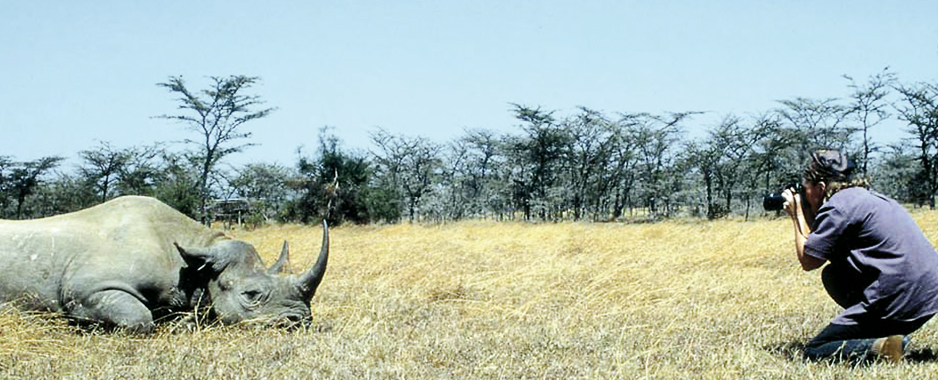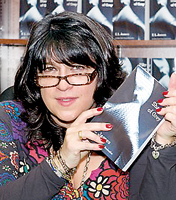True to life tales from the wild
Jan Latta decided to switch careers the day she looked a wild mountain gorilla in the eye. “The experience changed my life,” says the Australian author of her trip to Rwanda in 1994. It’s when she learned that there were only 600 of those majestic apes left in the world. Though she felt desperately sad at first, it was the impetus she had been waiting for. Since then, Jan has gone on to author over a dozen books, each focusing on a single endangered animal.

Magazine cover and pictures for this story courtesy Jan Latta.
Written with young readers in mind, they’re meant to be educational and interactive. They’re also, not incidentally, filled with exciting encounters – Jan’s books are based on her experiences with chimps in Uganda and pandas in the mountains of China; she’s photographed lions in Zambia, been charged by elephants in Amboseli and has come to Sri Lanka looking for leopards.
Jan’s favourite place in the world might just be Africa, which she’s visited eight times. She has also been to China, Borneo and India. Since she travels alone and relies on a single local guide to accompany her into the wild, Jan’s motto is research and more research. It’s something she takes pains to emphasise when speaking at a festival or in a classroom. “When I’m doing school shows, I use the word ‘home work’ about ten times so teachers love me,” she says. It’s the research she says that helps her make the right calls when faced with a charging angry male orangutang, as well other mundane tasks such as the planning of her books and photographs.
However, Jan knows she can count on her subjects to throw in the odd surprise. Having read about orangutans for her book ‘Ollie The Orangutan’, Jan had not come across any references to them having any great love for water but while relaxing in a forest in Borneo she watched as a female immersed herself in the river – “like a woman enjoying a day at the spa.” She continued to observe as the animal finished her dip and then luxuriously dried her lovely orange gold pelt in the sunshine. Another time, a mother and baby came right up to her, took her bottle of water from her, delicately peeled away the cellophane, unscrewed the cap and drained it dry. One of the great perks of the trip? Holding a baby orangutan. Still, her favourite encounter of all-time might just be with the cheetahs in Nanyuki.
An astonishing picture of one snuggling up to her is one of her most cherished memories. “I’ve got my hand on the cheetah’s throat, I just wanted to feel the purring,” she says, explaining that later they heard that one of the animals had spent some time as a cub in the company of humans. Jan says such encounters can happen only because she’s unafraid of the animals.
Whatever the reward, choosing to self-publish her books means each expedition is an expensive gamble. “No publisher is going to give you $15,000 to maybe find an animal in the wild,” she admits ruefully. She relies on a good distributor and is pleased to report that the books have now been translated into Japanese. For better or worse being at this helm allows her to take her time. The book on leopards took her 15 years and she only managed to finish after a visit to Yala where she was thrilled to stumble over several leopards.

Photographing wild animals has taught her a myriad of lessons – be careful around a mother and her child, never use a flash in the wild, follow the trail of fresh, steamy poop, and above all, be patient. It can take days to find an animal (it took her 3 weeks to find her first tiger in India) and hours for them to relax and allow you to get close enough for a candid photograph.
Choosing to be an author and photographer has been an indisputable improvement on her previous career in advertising. She’s not allowed all that experience to go to waste and applies it to finding interesting ways to present her work. A series of videos – one for each book – have been uploaded to Youtube and make for handy tools particularly when Jan speaks with children whose first language isn’t English.
She spends her time in between books, travelling and talking about them. Her books follow a simple format – written as if the animal were speaking and telling the reader all about themselves. She typically includes factoids, fun activities as well as a little history of how the book was written. In Sri Lanka, this included her camping out in Yala and taking twice a day rides through the park with her guide Noel Rodrigo.
Jan expects a busy year ahead and says she’ll be dreaming and saving up for an expedition to South America where she wants to make the acquaintance of a few sloths. These, the world’s slowest moving animals live in the trees, feast on buds, shoots and tender leaves and spend an inordinate amount of time hanging upside down – and Jan just can’t wait to meet them.
Follow @timesonlinelk
comments powered by Disqus



























